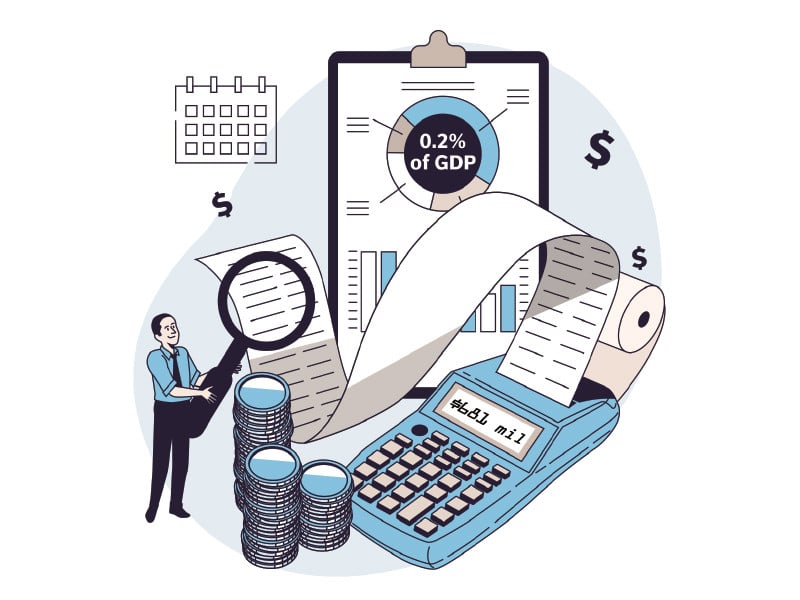By Mehtab Haider
Published in The News on June 20, 2022
ISLAMABAD: The Medium-Term Budget Strategy Paper for 2022-23 to 2024-25 envisages slowing down of GDP growth ranging from 5 to 6.2 percent. The government will focus on reducing the fiscal deficit from 7.1 percent of GDP in the outgoing fiscal year to 2.9 percent of GDP in the financial year 2024-25. There will be no fiscal space available to utilise more funds for Public Sector Development Program (PSDP) and it will be hovering around a maximum of Rs850 billion till 2024-25.
The allocation of the defence budget is projected at Rs1,523 billion in 2023, Rs1,570 billion for 2023-24 and Rs1,630 billion for 2024-25. The subsidies, which stood at Rs1,515 billion in the outgoing fiscal year, will go down in years to come and are projected to stand at Rs550 billion by 2024-25. The pension bill stood at Rs530 billion for 2022-23, which will go up to Rs568 billion in 2024-25. The running of civil government stands at Rs550 billion for 2022-23, which will be increased to Rs601 billion. The PSDP stands at Rs727 billion for budget 2022-23, which will be increased to Rs850 billion in 2024-25.
The Medium-Term Budget Strategy Paper for 2022-23 to 2024-25 prepared by Ministry of Finance and approved by the federal cabinet states that in order to address the macroeconomic imbalances, for FY2023, real GDP growth is expected to slow down, however, afterwards, strong recovery of the economy is expected.
Thus, over the medium-term, growth is expected to return to levels even higher than historical trends with average rates of 6.0 percent in FY24-25. For FY2023, inflation is expected to be 11.5 percent on account of increase in international commodities prices.
Amongst the primary objectives of the Medium-Term Fiscal Framework is to facilitate medium term policy-formulation based on reliable projections of revenue and expenditure.
It reflects various sources of revenues and heads of expenditures, in view of the historical trends as well as new measures, specific needs, andthe government’s strategic priorities in the medium term. The framework also highlights the fiscal balance and primary balance of the federal and general government.
In order to project the overall fiscal balance, estimated levels of provincial surpluses have also been worked out. Pakistan’s gross federal revenues are expected to be at 11pc of GDP in FY22 and stabilise at around 12 percent of GDP in the medium term. Transfers to provinces are expected to follow the same dynamics assumed in the gross federal revenues. The cornerstone of the government’s plan is to reduce deficits to restore fiscal sustainability in the medium to long term. Fiscal deficit is the key driver of macroeconomic instability in Pakistan. During the last three years, fiscal deficit was Rs4,000 billion per annum on average. From FY2014 to 2018, however, the fiscal deficit was only Rs1,671 billion per annum.
The higher fiscal deficit not only results in an increase in debt but also puts a strain on the current account balance. The key reason for a high fiscal deficit in the last four years has been the decrease in tax-to-GDP ratio of the country. In 2017-18, FBR tax-to-GDP ratio was 11.7 percent which decreased to just 8.5 percent in FY2020-21. On the other hand, there were slippages in expenditure which further exacerbated the fiscal deficit situation in the country.
In view of the foregoing, the key objective of budget for FY2022-23 is to reduce fiscal deficit. This will be done by increasing tax-to-GDP ratio and curtailing unnecessary expenditure. On the expenditure side, the government will strive to rationalise non targeted subsidies, reduce the losses of public sector enterprises through improved governance and cut down ostentatious expenditure through an austerity drive.
The Budget 2022-23 will aim to move away from non-targeted subsidies to create fiscal space to protect the poor from inflation. The CPI inflation during July-Mar FY2022 was recorded at 10.8 percent as against 8.3 percent during the same period last year. The government will take all possible measures to contain the current surge of inflation. However, given the worldwide environment, bringing current inflation down will require some time and should not come at the cost of a recession. Therefore, the government plans to divert resources from non targeted subsidies towards protection of poor. These subsidies will be tailor-made to provide relief to poor in the difficult time. The government will continue with the social protection programme through greater funding for the BISP.
Optimal mobilisation of revenue, broadening of tax base, reduction in exemptions, efficiency in revenue administration: Key strategic priorities of the government include optimal revenue mobilisation, broadening of tax base and increase of tax net, reduction in tax expenditure, efficiency in revenue administration, increase in ratio of direct taxes and simplification of procedures for facilitation of taxpayers. In view thereof, challenging revenue projections have been worked out for the medium term.
The government will continue the programme for Public Finance Management (PFM) reforms with a view to get better value of its expenditure. The government will continue its policy of implementation of the Public Finance Management Act, 2019. In this regard, new set of rules and regulations are being developed.
The expansion of the Treasury Single Account beyond Divisions and Attached Departments will be continued and the effectiveness of result-based budget management will be improved for greater accountability for the public expenditure.
The government will work on the new NFC Award in accordance with the provisions of Constitution of Pakistan. It is high time to consider sharing of expenditures on social sector and other subjects including health, education, agriculture and community development with the provincial governments. Federal PSDP shall focus on core strategic national level development projects only. Government will also focus on cash forecasting, commitment control and cash management leading to Treasury Single Account System. The implementation of efficient cash management system will improve the overall public finance management system of the country.






